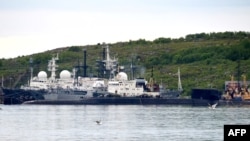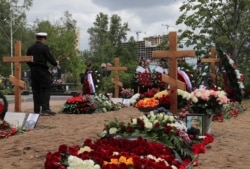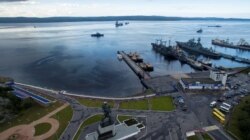The blaze on board a nuclear-powered Russian deep-diving submersible that killed 14 elite crewmen last week has cast some light on Russia’s top secret underwater intelligence service as well as its growing focus on the resource-rich polar region.
The Russian navy officers who died in the fire July 2 while the super-secret submarine was in the Arctic Ocean were buried Saturday in St. Petersburg. Authorities still have not disclosed what triggered the blaze on the Losharik, an AS-12 nuclear-powered spy submarine, and the pride of Russia's deepwater intelligence gathering program.
The 60- to 70-meter long vessel was launched in 2003 with the capacity to dive 6,000 meters. This particular sub was in Russian territorial waters when the fire started. Norwegian fishermen told local media they saw the vessel surface abruptly near Ura Bay, about 100 kilometers east of the Norwegian border — along with men rushing around the deck, but did not spot any smoke. Russia’s TASS news agency reported that crew members died because they inhaled toxic fumes.
Later, the fishermen said they saw bodies being transferred from the Losharik to a larger Russian naval vessel, believed to be its mother ship Belgorod, and two tugs, which arrived quickly. The fire wasn’t acknowledged by the Kremlin for 24 hours and the incident has been shrouded in secrecy with information given out reluctantly. Russian officials have focused their remarks on the bravery of the crew members, all of whom were officers, suggesting their mission was highly sensitive.
According to the Norwegian Radiation Protection Authority, the accident was triggered by a gas explosion. Russian officials will only say the fire started in a battery compartment.
Much of the international media attention has focused on whether there was any radiation leak from the incident, something Russian officials have denied strongly. Some analysts argue the Kremlin’s caginess was due to injured pride or the need to cover up a radiation hazard.
But a high-level of secrecy has always surrounded the Losharik and the other submersibles in a small fleet maintained by the Main Directorate of Deep-Sea Research, known as GUGI, a branch which reports directly to the General Staff of the Armed Forces.
"The Losharik advanced mini-submarine…is among the most secret vessels of the Russian navy,” tweeted Carl Bildt, a former Swedish prime minister and now a co-chair of the European Council on Foreign Relations, a research institution.
The diminutive subs are packed with sophisticated hydrographic data-gathering equipment and advanced acoustic systems. They can be used to monitor, tap and cut undersea communications cables, spy on foreign submarines and forecast ice floes, say Western military analysts.
The Losharik and other subs in the GUGI fleet are also believed capable of placing noise-making devices on the sea-bed to disguise the churn created when Russian submarines sail out from the Kola Peninsula to the North Atlantic.
“This is a great loss for the Navy, and yes, also for the Army,” Russian President Vladimir Putin told his defense minister, Sergey Shoigu, who went to the Russian Northern Fleet’s headquarters in Severomorsk fewer than two days after the blaze. Among the crew members who died were 12 captains, two of whom were awarded the title Hero of the Russian Federation.
Shoigu described the crew as “unique military specialists, highly qualified professionals, performing important research on the Earth’s hydrosphere.”
“It is difficult to believe that the typical compliment, 20-25 crewmen, would consist of 7 Captains first rank, including two who had been awarded as heroes of the Russian Federation, unless they were conducting some important research mission or perhaps test,” according to Michael Kofman, a military analyst at the Wilson Center, a Washington-based research group. Writing on his blog, he said: “Standard complement or not, either way, the deaths of these senior officers are likely to be a great loss not just for the Russian Navy, but also for GUGI’s technical efforts.”
The Kremlin has shown increased interest in securing economic and military dominance in the Arctic, according to Pentagon officials. They say the Kremlin worries about the Arctic as a security liability for Russia but also views it as a potential source of great mineral wealth, which it is determined to claim as its own as the shrinking polar ice opens new opportunities for resource exploration as well as to establish new shipping lanes.
Talking about development plans in 2017, Putin said, “Russian wealth is in the Arctic.” He estimated it contained $35 trillion worth of untapped oil and natural gas reserves as well as rare minerals. Half of all the Arctic coastline runs along Russia’s northern shores.
The Norwegian government has complained about heightened military activity close to its borders, which it has described as “aggressive.”
In March, Norway’s defense minister said Russian forces had actively disrupted GPS signals during Trident Juncture, the largest NATO war games since the end of the Cold War, conducted around northern Europe and the Arctic in late 2018. “Russia asked [us] to give proof. We gave them the proof,” said Frank Bakke-Jensen.
Russia’s Izvestia newspaper reported in May that the country’s Northern Fleet had established an electronic warfare “shield” along the Arctic coast and that it was capable of jamming satellite and drone communications, GPS signals, and other navigational system at ranges of up to 8,000 kilometers.
The Pentagon has requested funding for a new strategic port in the Arctic to counter the surge in Russian military activity in the region. This year, Russia opened a new surveillance base, nicknamed Northern Clover, for its trefoil shape, on Kotelny Island, between the Laptev Sea and the East Siberian Sea. The base has been constructed so personnel can move throughout the sprawling facility without going outdoors, where winter temperatures can fall to minus 50 Celsius (minus 58 Fahrenheit).














